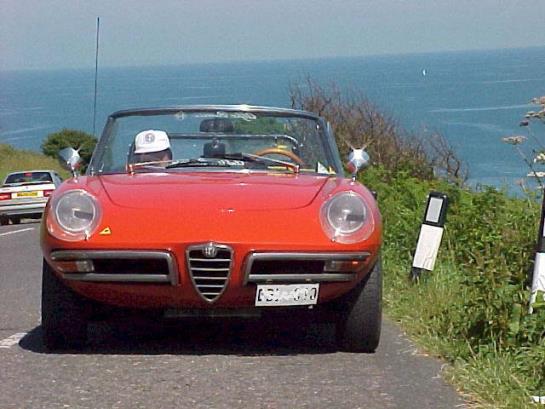|
Buying a Duetto part 1
Let me tell you once and for all, spares are no problem for your Alfa Romeo. There are lots of vendors and sources on the web. Try Google for instance. The tricky part might instead be to find the Alfa you are looking for.
When the first Spider, named the Duetto in a competition, was launched at the 1966 Geneva Motor Show, it attracted a mixed reception. BTW, Alfa Romeo never launched the Spider under this name, they only used Alfa Romeo 1600 Spider in the official sales material. The name Duetto was abandoned by Alfa, there was a biscuit! with the same name and Volvo had a delivery van with a similar name, the Duett in the 60's. Many spectators felt that the Pininfarina-designed body missed the mark. But everybody agreed the new Alfa drove delightfully. Its 1,6-liter alloy engine and sharp handling were universally praised.
A year later in 1967, the Duetto became the legendary 1750 Spider Veloce, when it was given the 1779 cc engine used in the GTV and, in 1968, it was joined by the identical 1,3 liter 1300 Spider Junior. Round-tailed rear end of early Spiders considered by most to be the more desirable. Even with the optional hardtop fitted, the car still retains its elegant lines. In 1970, both versions received a re-styled rump, the rounded attractive round-tail being replaced by a sharply cut off Kamm-tail.
In 1971 the Spider got the sweet 2-liter Alfa engine which it retains today. The name was now Spider 2000. UK imports of the Spider ceased in 1977 while most production was diverted to the insatiable American market, besotted with images of Dustin Hoffman behind the wheel in The Graduate. However, in the UK Bell & Colvill began to import Spiders from 1983 onwards, converting cars to right-hand drive. As of July 1990, the Spider once again was available direct from Alfa Romeo.
The Spider has been a classic hit for several years. The combination of the syllables in "Alfa Romeo", coupled with the rarity of any affordable open sports cars from this era, makes the Spider irresistible.
In today's market, even the best of the early Spiders and Duetto is unlikely to exceed £ 12 - 15.000, and reasonable cars can be picked up for half that figure. But, inevitably, there are pitfalls awaiting the aspiring Spider owner, who must be certain not to be blinded by the undoubted charms of this smooth Italian. As with most Alfas, the biggest single enemy is rust. True, the Spider is not afflicted to the same extent as the Alfetta or the Alfasud, but compared to other metal-clad cars, the Spider is a body just itching dissolve. Alfas need to be driven regularly since they do not deal well with sitting.
The problem stems from Alfa Romeo's rather feeble attempts at rust prevention. Pininfarina assembled the bodies before given a primer coat, so that areas unexposed to the spraying machinery were left bare and unprotected.
Keeping a Spider garaged or car covered always pays off.. Just storing it outside and not driven it will sooner or later cause rust, electrical problems etc. Water pools and muck and everything, you know what I mean. . . Trouble ahead if so!
The best advice when checking an Alfa is therefore; make sure that the bodywork is sound. Go to the service-station and lift the car so you can examine it from every angle. Mechanically, any problem can be sorted out fairly simply, but a rotten body is a lousy project.
Check www.highwoodalfa.com for panels and parts. It is important to control all around the sill areas. Do not forget the wheel arches, which sometimes are notorious water-traps, the entire floor including the boot, plus the front cross-member underneath the radiator. Watch out for patch-up jobs using bridging pieces of metal to disguise more serious corrosion elsewhere.
Very poor Spiders can be made to look great cosmetically, and fetch a high price on the strength of that. But still, it's the underneath that counts. What may look like superficial rust bubbling could mean that the inner section is badly corroded. Peeling back the rubber mats at the door base can reveal a rotten inner sill wall. Check seat runners, they can indicate a rotting floor too.
Another rust area is the front jacking point. If this is gone, the crucial inner sill is also likely to be rusted. Any plating preventing a look at the inner sill around the jacking point is bad news. Lift the carpets to check the floor, inspect the inner sills from the cockpit, and check the seat sliders for rust.
On Duetto and Spiders, the Round-tail rear tends to be a vulnerable to attacs of the orange enemy, rust. Replacement panels are available, but might make a big hole in your wallet. Sometimes, the rear wings are close to impossible to find, but don't give up. Try the vendors on the web. |

